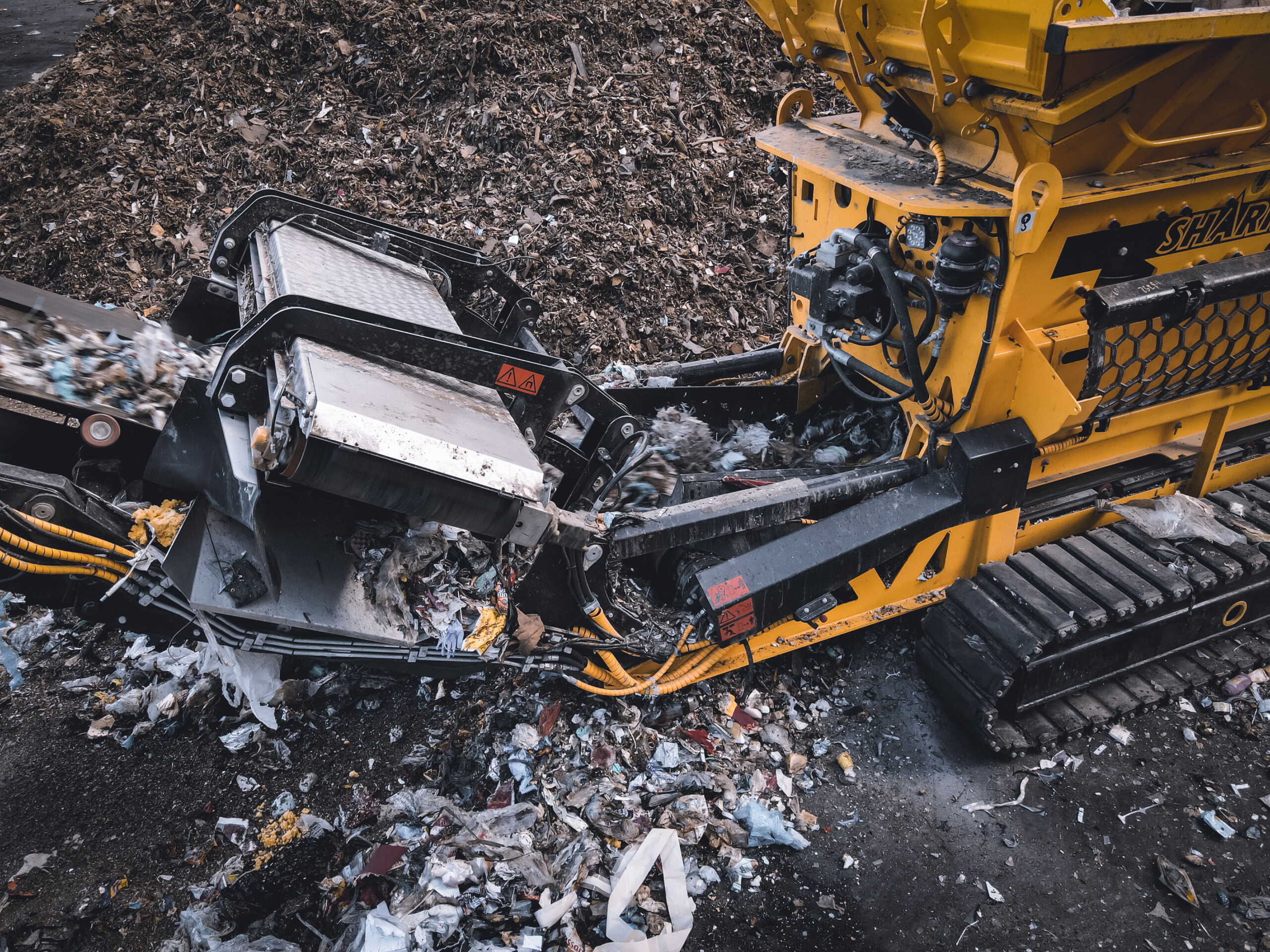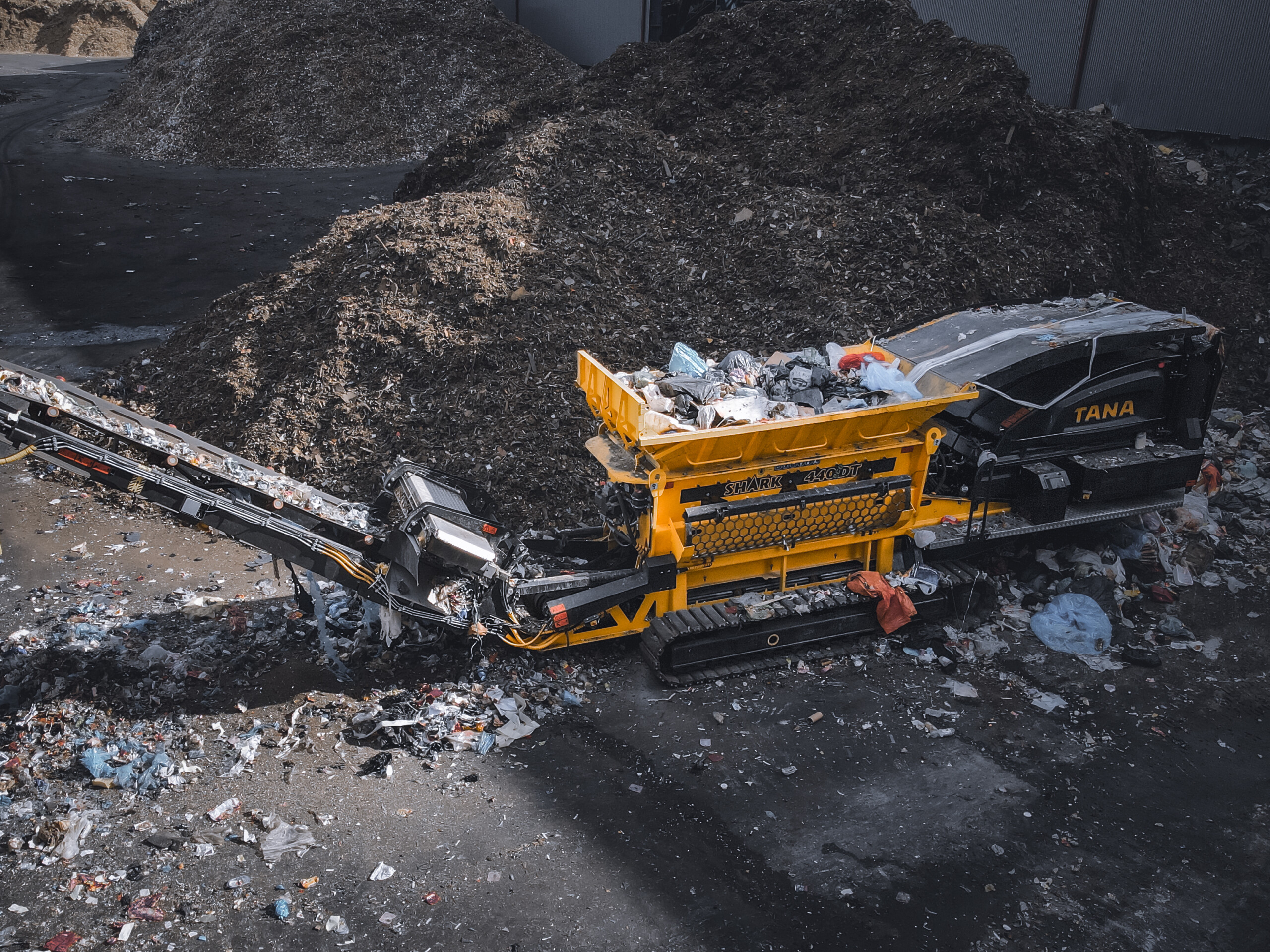The solutions offered by the environmental technology company Tana for shredding solid waste have a reputation as pioneers, especially in handling the most difficult types of waste. Many materials end up as waste that can be too tough to process cost-effectively. As a result, a huge amount of valuable waste in the world remains unutilized, which increases the burden on the environment.
The advantage of TANA shredders is their versatility. With the same machine, solid waste can be handled practically just like any waste.
Versatility is our overwhelming advantage
“Bottlenecks” in the recycling of solid waste do not hamper the operations of TANA waste shredders, whether they are caused by ship ropes that are easily twisted into knots, car tyres, layered items such as large rolls of felt or plastic, or hard-to-recycle mattresses with metal springs.
Rolls and tyres can be fed into TANA shredders whole, so they do not need to be separated from the waste stream. Metal rods are not a problem either, as long as the material strengths are within reasonable limits. In fact, all solid materials can be shredded with the exception of heavily reinforced concrete and large, strong-walled metal materials such as car cylinders. TANA shredders are not designed to be primary stone crushers, but construction waste, for example, is a very typical type of waste among Tana’s customers. Concrete waste is also not a problem, although in larger quantities it can cause faster wear on the shredder.
“TANA shredders are most ideal at handling versatile and difficult waste. The shredding process is the same regardless of the power source and material flow. The more diverse and challenging the needs for material reduction, the better TANA shredders do in comparison to other solutions and the faster the investment pays for itself,” says Eetu Tuovinen, Product Manager at Tana.
TANA shredders process a wide variety of waste worldwide
In the Benelux markets, for example, TANA shredders are used to process fishing nets and ship ropes, where the strength and entanglement of the material are a challenge in the process, as well as greenhouse waste, where tomato vines are entangled in support lines.
“These are obviously very niche fields. In addition to having to process wood, for example, everything else can be processed with our shredders. For example, our customers in Finland, Estonia, the United States, Australia, Cyprus and Turkey process a lot of car tyres and other waste from traffic using our waste shredders. Two material streams are typically obtained from car tyres: rubber crumb in a particle size specified by the customer, which can be used as refuse-derived fuel or for earthworks, for example, and ferrous metal separated from the material stream by a magnet, which can be sold to steel mills for further processing,” Tuovinen explains.
TANA waste shredders manifest Tana’s promise: “From waste to value”
It is surprising how many kinds of waste and items there are in the world that are still not reutilised in many places. According to the European Environment Agency (EEA), for example, just 49 percent of municipal waste generated from housing is recycled in EU countries at the moment, while the recycling target is at least 55 percent by 2025, 60 percent by 2030 and 65 percent by 2035.
“The full potential of waste streams as a producer of added value is often not realised, for example in as a source of energy circular economy innovations. Using shredders can both promote the recycling goals according to the EU’s waste directive and reutilise waste as energy,” says Tuovinen.
The key factor in enabling waste to be reutilised is to tear it down into a suitable particle sizes. With TANA shredders, waste streams can be processed into the particle size specified by the customer on a wide scale, ranging from 50 to 500 mm. According to Tuovinen, adjusting the particle size is fast and easy thanks to the screen on TANA shredders.
The customer can also use the same machine to process different materials and particle sizes, varying them flexibly. This opens up new business opportunities related to the circular economy for waste treatment plants and their customers.
In 2024, Tana will launch a disc screen on the market that can be used to further enhance the recycling of municipal waste. A common problem in municipal waste recycling is organic waste. In some areas, up to half of mixed household waste can be biowaste. By screening the waste after shredding using a disc screen, organic waste can be separated and bio waste recycled, so it can be included in the recycling rate. In addition to municipal waste, almost all other materials that can be processed with TANA shredders can be screened with a disc screen.
Designed specifically for handling solid waste, as reflected in a high utilisation rate
TANA shredders have been designed from the outset for shredding solid waste, where they are still pioneers and stand out not only by their versatility but also by their high utilisation rate.
“Our shredders are designed to be durable and sturdy. They are subjected to incredibly hard use, rough weather and ‘terrible’ materials. Thanks to their smart design – especially how their construction is designed and how their ease-of-maintenance enables productive operating hours – it is possible to maintain a high utilisation rate,” Tuovinen says.
Due to their demanding applications, maintenance should be planned over a longer period of time in order to maximise the shredder’s value for as long as possible.
“The best way to use and maintain the shredder is to follow its maintenance programme. This starts with small everyday things, such as daily checks according to the maintenance manual, washing, and other small tasks. Increasing the utilisation rate optimises the process, which means money for the customer. Of course, it is also better from an environmental point of view, as optimisation also enables a reduction in emissions during the process,” advises Tuovinen.
In order to facilitate maintenance and extend the service life, Tana offers, for example, more wear-resistant alternatives than the rotors used on normal machines that reduce the need for welding, a central lubrication system that automates the greasing of the bearings on moving parts, and a more durable door made of special materials, and a dust removal system. Model-specific service kits are also available for all TANA models.
Reducing environmental impacts is an important motivational factor for personnel
“With the products we offer, we are often enablers of the circular economy in its initial phase. Mechanical waste treatment usually requires some kind of shredding process. With a TANA shredder, customers can handle solid waste in a very versatile way and materials that are considered very difficult and that most other machines cannot handle. Our competitors are mainly single-rotor slow shredders from other parts of Europe. Tana has been a trendsetter in this industry and sector from the beginning. We have developed our products by listening to customers. Our comprehensive dealer network in around 50 countries provides us with valuable feedback from the field,” Tuovinen says.
In terms of environmental impacts, another advantage with TANA shredders is that the waste travels as little as possible and can be collected in a variety of ways from the surrounding area, which minimises emissions due to logistics. Also, the small size of the particles created by shredding the waste reduces logistics and storage costs, and therefore also emissions due to the reduced need for transportation.
“The benefits depend on what the infrastructure in the respective market is like, at what radius the waste streams can produce the amount of fuel needed, what kind of processes are involved in the waste treatment and utilisation at each location, and what is the demand for recycled materials, which regulations also have an impact on. The cost structure and investment payback period is equated according to the amount of loss and resale. In general, however, a single investment in a multipurpose shredder can save both investment costs and reduce environmental impacts. And when it comes to the final disposal of the machine, as a metal product it is largely recyclable,” Tuovinen adds.
At the same time, he points out that, according to the EU’s waste directive, the best course of action is to completely prevent the generation of waste and to reutilise it. Tana’s shredders make it possible to recycle waste, that is to separate different materials and reutilise them, shred waste into smaller particles that can be used as energy, and now, during the green transition, also dispose of waste as efficiently and compactly as possible so that new landfills do not need to be established.
“I am personally motivated by these kinds of activities that do good for everyone by utilising waste in a smarter way. It makes working in the waste recycling industry exciting. Regulations are also guiding activities in the direction of green values in waste treatment. Clearly, more attention will be paid to these in the future throughout the world. In my opinion, the right things are being done here in terms of the big picture, even if this is a commercial activity,” summarises Tuovinen.

